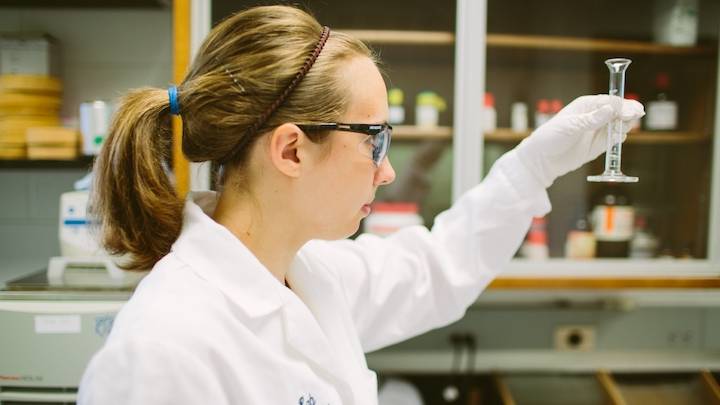Institutional Biosafety Committee

Calvin University is committed to ensuring the safe handling, storage, and disposal of recombinant DNA, biohazardous and potentially biohazardous materials used in research and academic activity on its campus.
Faculty and principal investigators who wish to use microbial agents, recombinant DNA, human or non-human primate tissue, blood or cell lines in teaching or research are required to register with the Institutional Biosafety Committee. The IBC maintains information regarding the use of biological materials at Calvin University. The IBC comprises one part of Calvin University’s compliance program. The IBC may work in conjunction with the IACUC and IRB.
It is an NIH requirement to comply with the NIH Guidelines for Research Involving Recombinant DNA or Synthetic Nucleic Acid Molecules at Calvin University because our institution receives NIH funding for rDNA/synthetic NA research projects.
It is expected that all personnel handling biological materials at Calvin University will comply with institutional, state, and federal guidelines and regulations.
Quick links
Download the biosafety application
What does the biosafety application involve?
Read Calvin's biosafety policy
See all Calvin environmental health and safety policies
Contact Us
IBC Chair: IBCchair@calvin.edu
Biological Safety Officer: BSO@calvin.edu
It is institutional policy that all research and teaching involving biological materials is evaluated to ensure that the appropriate training, biosafety measures, and biosecurity measures are taken to minimize risk to students and personnel, the Calvin community, and the surrounding general community and environment.
What does the IBC do?
The IBC reviews all research and teaching that involves recombinant DNA, and, infectious or potentially infectious agents to ensure that the work is conducted safely seeking to eliminate exposure to harmful agents for the student/worker, co-workers and the community. The Calvin University IBC also oversees all use of biohazardous materials at West Michigan Regional Lab (WMRL).
The Institutional Biosafety Committee (IBC) is responsible for providing local review and oversight of nearly all forms of research and teaching utilizing recombinant DNA and for providing review and oversight of experimentation that involves hazardous biological materials (e.g., infectious agents). Furthermore, the Institutional Biosafety Committee shall ensure that all recombinant DNA research conducted at or sponsored by Calvin University is conducted in compliance with the NIH Guidelines. The IBC reports to the College President via the Dean for the Natural Sciences and Mathematics.
How does the IBC process work?
Per compliance with the NIH Guidelines for Research Involving Recombinant DNA and Synthetic Nucleic Acid Molecules, if your teaching or research at Calvin University, including WMRL, includes any of the following, you must register your protocol by completing and submitting a Biosafety application for review by the Biological Safety Officer. Please allow at least 1 week for the BSO to review your application.
- Experiments qualifying as exempt under Section III-F of the NIH Guidelines.
- Experiments involving low risk biological agents (risk group 1).
- Blood draws that are being performed on patients not known to be actively infected with any bloodborne pathogens.
- Teaching activities that involve any of the materials listed above.
If your teaching or research at Calvin University, including WMRL, includes any of the following you must submit a biosafety application for full IBC review and approval. Please allow at least 2 weeks for review and approval. Research that requires IBC review and approval includes:
- Non-exempt experiments under Sections III-A, III-B, III-C, III-D, and III-E of the NIH Guidelines.
- Experiments involving the use of known human pathogens or risky environmental biological agents, including bacteria, archaea, viruses, fungi, protozoa, helminths, arthropods, prions, and biological toxins
- Research involving human cells/ tissues/ organs (unpreserved) and bodily fluids. This includes use of established or primary cell lines, stem cells, urine samples, known infected blood samples, fecal samples, and other bodily fluids.
- Experiments involving handling of non-human primate cells/ tissues/ organs/ bodily fluids.
- Experiments involving handling of any other animal cells/ tissues if animal was infected with a biological agent. (Example: animal brought in for necropsy after being found dead in wild).
- Use of animals as models for studying biological agents and toxins.
- Nanotechnology involving biological agents
- Teaching activities that involve any of the materials listed above.
What does the biosafety application involve?
Proposals describe the research plan, identify the hazards that exist, explain the provisions to protect participants, and outline what steps will be taken to comply with federally mandated guidelines. Each question in the protocol should be answered using non-technical language so that IBC members will have ample information to understand the proposed research project. The Principal Investigator must certify the accuracy of the information on file with the IBC on an annual basis. The IBC must be notified if there are changes in a research protocol, material usage, room changes or changes in staff. The IBC Biosafety application and review seeks to ensure that:
- you are conducting your work using the appropriate microbiological practices and laboratory techniques.
- you are conducting work in an appropriate location with adequate containment and personal protective equipment.
- biological materials are being stored and handled in accordance with relevant regulatory standards and with utmost safety in mind.
- all persons performing the procedures have sufficient knowledge and training to safely perform the procedures to which they have been assigned.
The BSO will/may discuss your protocol with you to seek clarifying information before submitting your application to the full committee. You and/or your personnel may be present at the IBC meeting to discuss and answer any inquiries about your application. The goal of the IBC is to ensure safety for all while fully supporting your proposed research activities.






